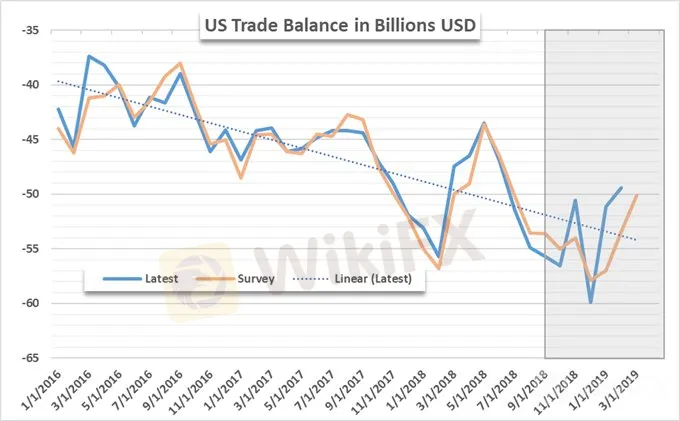简体中文
繁體中文
English
Pусский
日本語
ภาษาไทย
Tiếng Việt
Bahasa Indonesia
Español
हिन्दी
Filippiiniläinen
Français
Deutsch
Português
Türkçe
한국어
العربية
Stock Market Update: DIS Earnings Impress, Market Awaits Trade Data
Lời nói đầu:US stocks closed mostly in the red following a volatile day of trading. Traders will now look to Thursdays trade balance data for insight into the US-China trade war.
Stock Market Update Talking Points:
Disney released strong financial findings for their second quarter, which will likely offer buoyancy for the Dow Jones in Thursday trading
Stock traders will look to Thursday‘s US trade balance data to garner the impact the US-China trade war has had ahead of Friday’s deadline
With trade talks on the fritz and the month of May progressing, will the stock market crash and fulfill the “sell in May and go away” phenomenon?
Stock Market Update: DIS Earnings Impress, Market Awaits Trade Data
Amid a tumultuous trading session, Disney (DIS) was one of the few stocks on the Dow Jones to close in the green. Anticipation for their quarterly report saw DIS shares climb 1.21% in Wednesday trading – only to climb another 1.63% in the after-hours session as the results were released. A strong quarterly performance from one of the Dow Jones hottest stocks should inject optimism back into the Average on Thursday. Upon the earnings release, DIS remained within the implied price range and above the sizable price gap.
View our Economic Calendar for upcoming data releases.
While meaningful, Disney earnings pale in comparison to the larger issues plaguing the stock market. As trade war talks hit a rough patch, markets have sold off and the VIX has spiked. With all eyes on Friday‘s deadline, insight into the effects of the economic bout will be offered Thursday with the release of US trade balance data from March. A deficit of -$51.1 billion is expected, climbing from February’s deficit of -$49.4 billion.
US Trade Deficit Mounts

Source: Bloomberg
Since the US-China trade war began back in June 2018, markets have been offered 8 months of trade data. Because the data trails by two months, the shaded area above highlights data released from September to February – along with tomorrows expected balance. Although many economists have debated the exact impact of higher tariffs, the longer-term implications are unclear.
Similarly, the takeaways that can be garnered from the balance between the United States and China alone is also opaque. In February 2018, the United States imported $39.07 billion in goods from China while exporting $9.8 billion – resulting in a deficit of roughly -$29.26 billion. In 2019, imports in the month of February totaled $33.19 billion, accompanied by exports of $8.43 billion – resulting in a deficit of -$24.76 billion.

Source: Bloomberg
While the US-China trade deficit shrank in comparable time periods, the data is too noisy to draw a firm conclusion. One thing that is clear however, is the overall widening trade deficit of the United States. Despite the smaller deficit with China, the total balance continues to fall deeper into the red.
Over the last 9 years, the monthly average deficit has climbed to -$52.10 billion from -$32.49 billion. In tomorrow‘s report, traders and investors will scour the data for any indication a trend has developed from the trade war. To that end, specific sectors like agriculture (soybeans) and larger goods like airplanes and machinery will be important areas to watch. The data will assist investors in forecasting the ramifications of a potential change in levy rates on Friday. Check back at DailyFX.com for a breakdown and analysis of tomorrow’s trade data.
Miễn trừ trách nhiệm:
Các ý kiến trong bài viết này chỉ thể hiện quan điểm cá nhân của tác giả và không phải lời khuyên đầu tư. Thông tin trong bài viết mang tính tham khảo và không đảm bảo tính chính xác tuyệt đối. Nền tảng không chịu trách nhiệm cho bất kỳ quyết định đầu tư nào được đưa ra dựa trên nội dung này.
Sàn môi giới
IB
HFM
GTCFX
EC Markets
FXCM
Doo Prime
IB
HFM
GTCFX
EC Markets
FXCM
Doo Prime
Sàn môi giới
IB
HFM
GTCFX
EC Markets
FXCM
Doo Prime
IB
HFM
GTCFX
EC Markets
FXCM
Doo Prime
Tin HOT
EU tạm hoãn trả đũa thuế quan: Cơ hội đàm phán hay dấu hiệu cho cuộc chiến thương mại toàn diện?
Hai yếu tố quan trọng khi tra cứu và xác định một sàn Forex uy tín
Việt Nam đón làn sóng dịch chuyển chuỗi cung ứng toàn cầu
Giám đốc JPMorganChase và Chủ tịch Fed Dallas công khai ủng hộ Jerome Powell
Top 5 sàn môi giới bị tố cáo nhiều nhất tháng 06/2025
WikiFX Review sàn Forex ActivTrades 2025: Đánh giá chi tiết về uy tín và rủi ro
Việt Nam và chiến lược ứng phó sức ép thương mại đa chiều
Tin tức Forex 14/07: XM hỗ trợ giáo dục cho trẻ em tại Việt Nam
Chiến lược ngoại giao cây tre của Việt Nam giữa biến động toàn cầu
WikiFX - Cộng đồng tư vấn chuyên sâu
Tính tỷ giá hối đoái


